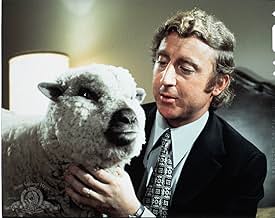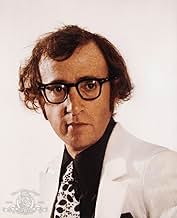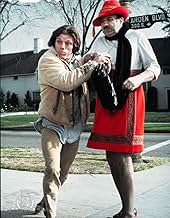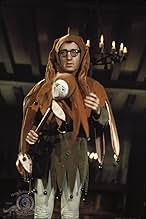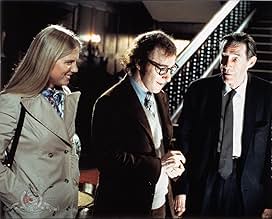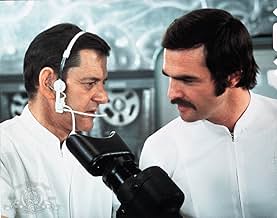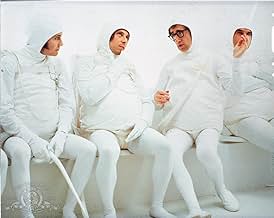Tutto quello che avreste voluto sapere sul sesso ma non avete mai osato chiedere
Titolo originale: Everything You Always Wanted to Know About Sex * But Were Afraid to Ask
VALUTAZIONE IMDb
6,7/10
43.062
LA TUA VALUTAZIONE
Sette storie stanno cercando di rispondere alla domanda: che cos'è il sesso? O forse non ci stanno provando.Sette storie stanno cercando di rispondere alla domanda: che cos'è il sesso? O forse non ci stanno provando.Sette storie stanno cercando di rispondere alla domanda: che cos'è il sesso? O forse non ci stanno provando.
Toni Holt Kramer
- Toni Holt
- (as Toni Holt)
Heather MacRae
- Helen Lacey
- (as Heather Macrae)
Recensioni in evidenza
Representing something of an early high point in Woody Allen's career, this scattershot spoof of David Rueben's highly popular sex-manual has become somewhat sadly overlooked in favour of the more mature and whimsical charms of 'Annie Hall' and 'Manhattan', but 'Everything you always wanted to know about sex' is just as enjoyable as his later works, if not more so.
Although the overt intellectualism that many of Allen's detractors criticize in his subsequent work is already beginning to take form here, not only in the concept (seriously, who'd adapt a sex-manual?) but also in execution, which owes more to the high-brow Fellini and Godard than the low-brow Mel Brooks or John Waters, includes a great deal of metaphysical surrealism, bizarre camera angles and deliberately self-indulgent dialog. Here Allen's filmmaking approach is more self-serving than ever before, casting himself as a medieval stand-up comedian, a heroic leading man and a sperm, yet still finding time to feature in a lengthy satire on early-seventies European cinema. The reason it all comes together without succumbing to self-importance is down to the simplicity and stupidity of most of the set pieces.
The more interesting segments come at the beginning of the film, and if seeing Woody trying hopelessly to unlock Lynn Redgrave's chastity belt and miss-quoting Shakespeare to form a condemnation of T.B. doesn't bring a smile to your face, then the sight of Gene Wilder in the throws of foreplay with a sheep will probably do little to convert you. Humour for the most is juvenile, puerile and immature, but carried off with such hilarious comedic style, that the Farrelly brothers should really reassess their careers. Allen is as likable as ever in his many surreal incarnations -- appearing in fifty percent of the sketches -- his ultimate triumph being the oily, Italian play-boy causing a stir when he and his frigid girlfriend par-take of a little outdoor nookie. And even if he is less confident when trying to be socio-satirical, as in the molestation game show, Woody still manages to inject a wit and ingenuity to the proceedings, always carrying off the gags to his trademark self-deprecating style.
However, despite technical assuredness, the finished product borders on the same hit and miss territory that befalls most anthology films, however, it has to be handed to Allen for making a genuinely intelligent movie that basically celebrates boob-gags and outbursts of rampant misogyny. The best policy with 'Everything you always wanted to know...' is to ignore the false starts of the later segments, and howl at the sight of Woody fighting a giant breast ("Don't worry, I know how to handle tits"). Nevertheless, if your idea of sophisticated humour doesn't include bestiality, orgasms, transvestism, homosexuality, ejaculation, perversion or Burt Reynolds, then feel free to give it a miss.
Although the overt intellectualism that many of Allen's detractors criticize in his subsequent work is already beginning to take form here, not only in the concept (seriously, who'd adapt a sex-manual?) but also in execution, which owes more to the high-brow Fellini and Godard than the low-brow Mel Brooks or John Waters, includes a great deal of metaphysical surrealism, bizarre camera angles and deliberately self-indulgent dialog. Here Allen's filmmaking approach is more self-serving than ever before, casting himself as a medieval stand-up comedian, a heroic leading man and a sperm, yet still finding time to feature in a lengthy satire on early-seventies European cinema. The reason it all comes together without succumbing to self-importance is down to the simplicity and stupidity of most of the set pieces.
The more interesting segments come at the beginning of the film, and if seeing Woody trying hopelessly to unlock Lynn Redgrave's chastity belt and miss-quoting Shakespeare to form a condemnation of T.B. doesn't bring a smile to your face, then the sight of Gene Wilder in the throws of foreplay with a sheep will probably do little to convert you. Humour for the most is juvenile, puerile and immature, but carried off with such hilarious comedic style, that the Farrelly brothers should really reassess their careers. Allen is as likable as ever in his many surreal incarnations -- appearing in fifty percent of the sketches -- his ultimate triumph being the oily, Italian play-boy causing a stir when he and his frigid girlfriend par-take of a little outdoor nookie. And even if he is less confident when trying to be socio-satirical, as in the molestation game show, Woody still manages to inject a wit and ingenuity to the proceedings, always carrying off the gags to his trademark self-deprecating style.
However, despite technical assuredness, the finished product borders on the same hit and miss territory that befalls most anthology films, however, it has to be handed to Allen for making a genuinely intelligent movie that basically celebrates boob-gags and outbursts of rampant misogyny. The best policy with 'Everything you always wanted to know...' is to ignore the false starts of the later segments, and howl at the sight of Woody fighting a giant breast ("Don't worry, I know how to handle tits"). Nevertheless, if your idea of sophisticated humour doesn't include bestiality, orgasms, transvestism, homosexuality, ejaculation, perversion or Burt Reynolds, then feel free to give it a miss.
Woody Allen is sometimes regarded as one of America's more eccentric filmmakers, and his decision to acquire the film rights to David Reuben's sex guide "Everything You Always Wanted to Know About Sex* (*But Were Afraid to Ask)" must, at first sight, have seemed one of his more eccentric ventures. I mean, just how do you make a film of a sex manual, without turning it into pornography? Allen, however, clearly thought that the title was too good to resist, and his solution was to make the film as a series of seven sketches, a structure influenced by the Monty Python style of comedy. (The Python's first feature film "And Now For Something Completely Different", also made as a series of short sketches, had come out the previous year). Each sketch is given the title of a question from Dr. Reuben's book.
As with a number of films of this type (a later Python film "The Meaning of Life" being a good example) the individual sketches very enormously in quality. The good:- "What Happens During Ejaculation?". This seems to be the sketch that most people remember the film for. I am not sure whether there was any direct inspiration, but the central conceit, namely that the human body is actually controlled by small humanoid creatures living inside it, seemed very similar to that of "The Numskulls", a cartoon strip from a British comic. The sketch depicts what happens to the owner of the body during a sexual encounter with his girlfriend, and stands out for the contributions of Burt Reynolds as a brain cell and Allen himself as a sperm. The joke is that spermatozoa form a crack paratroop-style military unit who have sworn an oath to fertilise the woman's ovum "or to die in the attempt". They all have the sort of gung-ho personalities familiar from war films, all except Allen's character who is cowardly, nervous and self-doubting. (But then, what Allen character isn't?) The most brilliantly funny part of the film.
"What Are Sex Perverts?" This section, filmed in black-and-white, features a game show called "What's My Perversion?", an obvious parody of "What's My Line?". The humour comes from the incongruity between the mood of the show and its subject matter as the four panellists discuss in the cheerful, breezy tone typical of fifties and sixties game shows whether the seemingly respectable middle-aged contestant is a rapist or a voyeur. (It turns out that his perversion is "Likes to expose himself on a subway"). Some have criticised this sketch as tasteless, but a bit of tastelessness is needed for a film like this to succeed; no-one ever made a successful sex comedy by scrupulously observing the canons of good taste.
These, however, were the only segments that I really enjoyed. The indifferent:-
"Do Aphrodisiacs Work?", or the story of a mediaeval king's jester who attempts to seduce the queen, but is foiled by her chastity belt. Nothing particularly original in this, despite attempts to work in references to Shakespeare's Hamlet, but there is some humour to be derived from seeing the standard Woody character, the angst-ridden 20th century urban intellectual, transported back to mediaeval Europe.
Why Do Some Women Have Trouble Reaching an Orgasm?, which deals with a woman (played by Woody's ex-wife Louise Lasser) who can only become sexually aroused when making love in public. This section appears to have been designed as either a parody of, or affectionate homage to, the Italian cinema of the fifties and sixties, and is entirely in Italian with English subtitles. This struck me as a bit of a gimmick, although those who are more familiar than I with the back catalogues of Michelangelo Antonioni and Federico Fellini might find something to enjoy.
And finally the bad:- "Are the Findings of Doctors and Clinics Who Do Sexual Research and Experiments Accurate?" This was obviously intended as a parody of cheap fifties horror films, but Woody clearly had difficulty integrating this particular concept into his overall scheme of making a series of sketches on the theme of sex. The central character is, ostensibly, a Kinsey-style sexologist who turns out to be a Frankenstein-type mad scientist, complete with an assistant named Igor. The scenes of a gigantic breast bouncing across the countryside are a feeble attempt at surrealism, like something from one of the most contrived Python sketches.
"Are Transvestites Homosexuals?" and "What is Sodomy?" I bracket these two segments together because both share the same fault; neither is in the least funny. The first, predictably enough, is about a man who likes to dress up in women's clothes; the second, perhaps less predictably, is about a doctor who falls in love with a sheep. (In normal usage the word "sodomy" refers to anal sex, not to sex with animals; perhaps Dr. Reuben's book did not deal with the subject of bestiality). Perhaps in 1972, in the early days of the so-called sexual revolution, it seemed daring merely to mention areas of human sexuality which had previously been taboo.(It is impossible to imagine a mainstream Hollywood film of this nature being made in 1952, or even 1962). Woody seems to have imagined that all he had to do was to refer to these two subjects, without bothering to treat them with any wit or humour, for people to start laughing. That might have worked in 1972 (although I doubt it); it certainly doesn't work today.
Five bad or indifferent sketches out of seven is not a very good strike rate, but I have given this film an above-average mark, largely because I couldn't stop laughing at the "sperm" sketch. 6/10
As with a number of films of this type (a later Python film "The Meaning of Life" being a good example) the individual sketches very enormously in quality. The good:- "What Happens During Ejaculation?". This seems to be the sketch that most people remember the film for. I am not sure whether there was any direct inspiration, but the central conceit, namely that the human body is actually controlled by small humanoid creatures living inside it, seemed very similar to that of "The Numskulls", a cartoon strip from a British comic. The sketch depicts what happens to the owner of the body during a sexual encounter with his girlfriend, and stands out for the contributions of Burt Reynolds as a brain cell and Allen himself as a sperm. The joke is that spermatozoa form a crack paratroop-style military unit who have sworn an oath to fertilise the woman's ovum "or to die in the attempt". They all have the sort of gung-ho personalities familiar from war films, all except Allen's character who is cowardly, nervous and self-doubting. (But then, what Allen character isn't?) The most brilliantly funny part of the film.
"What Are Sex Perverts?" This section, filmed in black-and-white, features a game show called "What's My Perversion?", an obvious parody of "What's My Line?". The humour comes from the incongruity between the mood of the show and its subject matter as the four panellists discuss in the cheerful, breezy tone typical of fifties and sixties game shows whether the seemingly respectable middle-aged contestant is a rapist or a voyeur. (It turns out that his perversion is "Likes to expose himself on a subway"). Some have criticised this sketch as tasteless, but a bit of tastelessness is needed for a film like this to succeed; no-one ever made a successful sex comedy by scrupulously observing the canons of good taste.
These, however, were the only segments that I really enjoyed. The indifferent:-
"Do Aphrodisiacs Work?", or the story of a mediaeval king's jester who attempts to seduce the queen, but is foiled by her chastity belt. Nothing particularly original in this, despite attempts to work in references to Shakespeare's Hamlet, but there is some humour to be derived from seeing the standard Woody character, the angst-ridden 20th century urban intellectual, transported back to mediaeval Europe.
Why Do Some Women Have Trouble Reaching an Orgasm?, which deals with a woman (played by Woody's ex-wife Louise Lasser) who can only become sexually aroused when making love in public. This section appears to have been designed as either a parody of, or affectionate homage to, the Italian cinema of the fifties and sixties, and is entirely in Italian with English subtitles. This struck me as a bit of a gimmick, although those who are more familiar than I with the back catalogues of Michelangelo Antonioni and Federico Fellini might find something to enjoy.
And finally the bad:- "Are the Findings of Doctors and Clinics Who Do Sexual Research and Experiments Accurate?" This was obviously intended as a parody of cheap fifties horror films, but Woody clearly had difficulty integrating this particular concept into his overall scheme of making a series of sketches on the theme of sex. The central character is, ostensibly, a Kinsey-style sexologist who turns out to be a Frankenstein-type mad scientist, complete with an assistant named Igor. The scenes of a gigantic breast bouncing across the countryside are a feeble attempt at surrealism, like something from one of the most contrived Python sketches.
"Are Transvestites Homosexuals?" and "What is Sodomy?" I bracket these two segments together because both share the same fault; neither is in the least funny. The first, predictably enough, is about a man who likes to dress up in women's clothes; the second, perhaps less predictably, is about a doctor who falls in love with a sheep. (In normal usage the word "sodomy" refers to anal sex, not to sex with animals; perhaps Dr. Reuben's book did not deal with the subject of bestiality). Perhaps in 1972, in the early days of the so-called sexual revolution, it seemed daring merely to mention areas of human sexuality which had previously been taboo.(It is impossible to imagine a mainstream Hollywood film of this nature being made in 1952, or even 1962). Woody seems to have imagined that all he had to do was to refer to these two subjects, without bothering to treat them with any wit or humour, for people to start laughing. That might have worked in 1972 (although I doubt it); it certainly doesn't work today.
Five bad or indifferent sketches out of seven is not a very good strike rate, but I have given this film an above-average mark, largely because I couldn't stop laughing at the "sperm" sketch. 6/10
The film is entirely about sexual perversions, even though it is not technically erotic
Allen has taken some of the most popular clinical treatments of sexual fetishes and has placed them into very unusual situations
Gene Wilder, for example, falls in love with a sheep; Woody Allen plays a medieval court jester who gets his lance stuck in his lady's chastity belt while the king is off fighting in the Crusades; a giant breast is released upon the countryside; an Italian couple can only find happiness in public sex; and we are taken into the inner labors of a male human body as it tries to seduce a woman in a car
Each individual scene is quite well done The tales are rapid filled with irony about the overly exaggerated importance of sex in our culture
Gene Wilder, for example, falls in love with a sheep; Woody Allen plays a medieval court jester who gets his lance stuck in his lady's chastity belt while the king is off fighting in the Crusades; a giant breast is released upon the countryside; an Italian couple can only find happiness in public sex; and we are taken into the inner labors of a male human body as it tries to seduce a woman in a car
Each individual scene is quite well done The tales are rapid filled with irony about the overly exaggerated importance of sex in our culture
While all the early Woody Allen films are funny and worthwhile, this is probably the most uneven to my taste.
Allen took the famous, serious non-fiction book about sex, and turned it into a series of short comedy pieces. A couple segments are pure genius (inside the male body during sex, Gene Wilder falling in love with a sheep), a couple are pretty good (Woody as a medieval court jester trying to have an affair with the queen, who is locked into a chastity belt, a mad scientist creates a giant milk squirting breast that goes on a rampage) and a few are real duds.
Also, of all the Allen films, this might have the worst DVD print/transfer quality.
It's bizarre and disturbing is that a lot of Allen's brilliant early work seems to be going out of print. Hopefully this is just a temporary state of affairs, and better re-releases are ahead. But if you're a fan you might want to grab copies of this, Bananas, Sleeper, Take the Money and Run, etc now, while you can.
Allen took the famous, serious non-fiction book about sex, and turned it into a series of short comedy pieces. A couple segments are pure genius (inside the male body during sex, Gene Wilder falling in love with a sheep), a couple are pretty good (Woody as a medieval court jester trying to have an affair with the queen, who is locked into a chastity belt, a mad scientist creates a giant milk squirting breast that goes on a rampage) and a few are real duds.
Also, of all the Allen films, this might have the worst DVD print/transfer quality.
It's bizarre and disturbing is that a lot of Allen's brilliant early work seems to be going out of print. Hopefully this is just a temporary state of affairs, and better re-releases are ahead. But if you're a fan you might want to grab copies of this, Bananas, Sleeper, Take the Money and Run, etc now, while you can.
Everything You Always Wanted to Know... is frequently looked down upon as it fulfils its promise completely. That is, it contains a lot of sex.
To downplay the film on such a level is to do it a disservice: what may be overlooked is that, apart from the subject matter and the brevity with which such a topic is treated, this is shot extremely well.
A notable example of this is Allen's technique of having actors speaking with their backs to the camera. A very European style of filming, and one which, understandably, is most brought into play during the third vignette, a pitch-perfect satire of continental cinema. Also look out for the grand-scale surrealism that occupies the last two sequences: a 400-foot breast rolling down a well-shot hillside or a giant tongue may seem crude in context, but looked at solely for cinematic technique this is pure Fellini. This may seem to be overstating it, but never has a bawdy, slightly crass, comedy vehicle been so well conceived for the big screen. Even the opening sequence involving a multitude of white rabbits is shot with the screen in mind, a twitching nose and red eye the only objects punctuating an effective white counterpoint for the introductory credits.
And so to the content itself, which doesn't match the quality of the production and sags in the middle. The first three sketches are quite wonderful, the third, as mentioned, is exquisite, and the scenes with Gene Wilder romancing a sheep may not be as sophisticated, but are probably the funniest. The first sketch sees Woody as a medieval jester paraphrasing Shakespeare, though the gags really don't get any better (or more tasteful) than "T.B. or not T.B., that is the congestion". For this is a film that has no limits, and its content flirts with notions of bestiality, transvestism, the female orgasm, ejaculation and sex in public places. Not all of these are carried off particularly well, the transvestite sketch falling resolutely flat. There is also evidence of Woody's homophobia, casting himself as a sperm dreading being ejected during a "homosexual encounter". In fact, an eighth sketch was filmed, which suggested homosexuality arises as a direct consequence of fear of women. This was cut not on bounds of taste but due to the fact that Woody couldn't think of a good enough punchline.
Worst point of the film though, has to be the "What's My Perversion?" segment. While extremely satirical, this one leaves an extremely bad taste in the mouth as Woody seems to be going full-out to offend with this piece. While the basic idea could cause some amusement, seeing a panellist quizzing a contestant as to whether he's a rapist or a child molester is several stages beyond funny. Simarily, the sketch ends with a Rabbi's wife on her knees eating pork. An unnecessary addition to the film.
However, it is of importance in terms of Woody's screen "character". The rough edges, arrogance and pseudo-intellectualism of his mid-seventies work onwards has yet to emerge, and here we still have Woody very much as he was in "Casino Royale" - ie., a bit of a nerd and on the losing end of life. Amazing to think that in just two years time he was writing himself as a lothario who was exceptionally good in bed.
In conclusion, then, a worthwhile view if you're a student of film or a fan of Woody's, but if you're watching this one for the comedy then it's purely hit-and-miss.
To downplay the film on such a level is to do it a disservice: what may be overlooked is that, apart from the subject matter and the brevity with which such a topic is treated, this is shot extremely well.
A notable example of this is Allen's technique of having actors speaking with their backs to the camera. A very European style of filming, and one which, understandably, is most brought into play during the third vignette, a pitch-perfect satire of continental cinema. Also look out for the grand-scale surrealism that occupies the last two sequences: a 400-foot breast rolling down a well-shot hillside or a giant tongue may seem crude in context, but looked at solely for cinematic technique this is pure Fellini. This may seem to be overstating it, but never has a bawdy, slightly crass, comedy vehicle been so well conceived for the big screen. Even the opening sequence involving a multitude of white rabbits is shot with the screen in mind, a twitching nose and red eye the only objects punctuating an effective white counterpoint for the introductory credits.
And so to the content itself, which doesn't match the quality of the production and sags in the middle. The first three sketches are quite wonderful, the third, as mentioned, is exquisite, and the scenes with Gene Wilder romancing a sheep may not be as sophisticated, but are probably the funniest. The first sketch sees Woody as a medieval jester paraphrasing Shakespeare, though the gags really don't get any better (or more tasteful) than "T.B. or not T.B., that is the congestion". For this is a film that has no limits, and its content flirts with notions of bestiality, transvestism, the female orgasm, ejaculation and sex in public places. Not all of these are carried off particularly well, the transvestite sketch falling resolutely flat. There is also evidence of Woody's homophobia, casting himself as a sperm dreading being ejected during a "homosexual encounter". In fact, an eighth sketch was filmed, which suggested homosexuality arises as a direct consequence of fear of women. This was cut not on bounds of taste but due to the fact that Woody couldn't think of a good enough punchline.
Worst point of the film though, has to be the "What's My Perversion?" segment. While extremely satirical, this one leaves an extremely bad taste in the mouth as Woody seems to be going full-out to offend with this piece. While the basic idea could cause some amusement, seeing a panellist quizzing a contestant as to whether he's a rapist or a child molester is several stages beyond funny. Simarily, the sketch ends with a Rabbi's wife on her knees eating pork. An unnecessary addition to the film.
However, it is of importance in terms of Woody's screen "character". The rough edges, arrogance and pseudo-intellectualism of his mid-seventies work onwards has yet to emerge, and here we still have Woody very much as he was in "Casino Royale" - ie., a bit of a nerd and on the losing end of life. Amazing to think that in just two years time he was writing himself as a lothario who was exceptionally good in bed.
In conclusion, then, a worthwhile view if you're a student of film or a fan of Woody's, but if you're watching this one for the comedy then it's purely hit-and-miss.
Lo sapevi?
- QuizDr. David Reuben, the author of the source book "Everything You Always Wanted to Know About Sex (But Were Afraid to Ask)," did not like this movie, and in an interview with the Los Angeles Herald-Examiner, said: "I didn't enjoy the movie, because it impressed me as a sexual tragedy. Every episode in the picture was a chronicle of sexual failure, which was the converse of everything in the book."
- BlooperAt the end of the fourth segment the transvestite man's wife exclaims: "The look on their faces when the police removed your hat!" and the man laughs in response. But it was actually the man himself who had removed his hat on being recognized by his wife.
- Curiosità sui creditiOpening and closing credits shown over footage of rabbits.
- Versioni alternativeAfter being banned in Ireland on March 20 1973, a cut version was passed in 1979 and theatrically released in 1980. This edited:
- the scene in which a shepherd goes to see a doctor and tells him how he has fallen in love with a sheep. The line, "the greatest lay I ever had" was removed.
- The bread intercourse scene was removed entirely.
- ConnessioniFeatured in Hollywood vs. Religion (1994)
- Colonne sonoreLet's Misbehave
(1927)
Music and Lyrics by Cole Porter
RCA Records
Played and Sung offscreen during the opening and closing credits by Irving Aaronson and His Commanders (uncredited)
I più visti
Accedi per valutare e creare un elenco di titoli salvati per ottenere consigli personalizzati
Dettagli
- Data di uscita
- Paese di origine
- Lingue
- Celebre anche come
- Everything You Always Wanted to Know About Sex * But Were Afraid to Ask
- Luoghi delle riprese
- Aziende produttrici
- Vedi altri crediti dell’azienda su IMDbPro
Botteghino
- Budget
- 2.000.000 USD (previsto)
- Lordo Stati Uniti e Canada
- 18.016.290 USD
- Lordo in tutto il mondo
- 18.090.065 USD
- Tempo di esecuzione1 ora 28 minuti
- Colore
- Mix di suoni
- Proporzioni
- 1.85 : 1
Contribuisci a questa pagina
Suggerisci una modifica o aggiungi i contenuti mancanti

Divario superiore
What is the streaming release date of Tutto quello che avreste voluto sapere sul sesso ma non avete mai osato chiedere (1972) in the United Kingdom?
Rispondi

